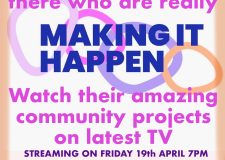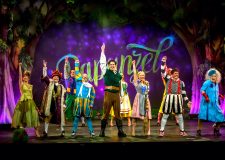Film: The Wolverine Interview
Holly Cozens speaks to James Mangold, director of the new film about the hairy, adamantium-laden superhero

Which was your favourite scene in the movie to shoot?
‘Well I always look forward to when I’m watching the film is the kick off. Well first of all the opening sequence, the bombing of Nagasaki. That one is a favourite of mine in the sense that it is a favourite, I very much like the statement the movie makes from the get go about tone, that it takes itself seriously. It also captured in that one scene two styles, both the quiet and the intense.
It opens, there’s no music you’re just there, the sound of planes and a little bit of hubbub, there’s someone watching and then all hell breaks loose. If you were looking at the film as a piece of musical composition, the films follows in a mini-style that same kind of structure, pulling back the reins and then letting go very hard. But I also really enjoy watching and feeling for the audience, the fairly deliberate and meticulous setup of all these characters and the world in Japan.
I mean the movie almost has two beginnings, one kind of finding Logan in the Yukon and bringing him to Japan and there’s so many people to meet and so much intrigue in the world he lands in. Old man Yashida dies, the funeral sequence suddenly, when the violence kicks off in that sequence it’s really gratifying and the result of a lot of work to watch the film unleash what is like ‘well if you thought we forgot that we have to deliver this’.
It’s really fun to unleash it and remind the audience of the opening sequence but also for the next 20mins of the film it’s almost a non-stop assault on that side. These are odd things you think about as a filmmaker, changing up the rhythms, the architectural rhythms of these movies as well as the obvious story ones. Also I have a lot of pride in it because it’s this unique thing obviously to make anything that involves thousands of extras and special effects rigs and claws and CG and there’s plenty required but you also want to make it look like its happening now and so it’s planning.
Also one of the things that can happen when you start planning a sequence on paper is that there’s temptation for the director to get quite fruity with the camera, you start flying through keyholes and with the ability to dream on paper you do the things you’d never do and I wanted to somehow do the action in the film like it had been shot in kind of a 70s style action film or Outlaw Josey Wales or French Connection. I wanted it to feel like there was simplicity and urgency to the action even though we’re using CG and claws.’
Despite modern Japanese influence, you’re starting with perhaps one of their most important events in history, the bombing of Nagasaki. Did you feel a responsibility to respect that?
You take it seriously. The way you respect something like that is you take it seriously. I mean I also think the distance helps you do something like that. For instance I didn’t tackle the tsunami, I didn’t try and integrate that, in a way it’s too close in a film this type to be trying to fold that in and I do think they’ll be some sensitivity in Japan about it. I think the reality is that we are respectful and I was checking in a lot with our Japanese cast and kind of trying to feel them out and how they felt about it.
I think one of the things they felt is that the young people of Japan are no longer the generation who have lived or necessarily their parents went through this so it’s becoming more of a distant tale so for a lot of the Japanese cast I spoke to in the movie, it was kind of a reminder. What I felt working on it was it is kind of amazing that this very important nation, although small in size, have endured 3 out of the 4 great nuclear catastrophes of modern ages and have somehow bounced back and continued to be a cultural and industrial force.
That somehow that even after I had developed the script with the writers and was there shooting and living there, hit me more palpably how, I mean we were shooting in the area where this happened and the sense that life goes on was real and one that had real thematic relevance for a character like Logan who at the beginning of this film was a little bit lost in his own sorrows if you will and not getting on with it.’
Does it get you back to the essence of filmmaking, driving up in a van through Tokyo and run round the streets with a camera?
‘On the day we were doing that I was thinking this is madness because you also had so long before a cop discovered you. We honestly were stealing it so you were like, literally the Japanese production advisors would say “well you have probably 5 or 6 minutes before catches on to what you’re up to” and we’d have to hop back in the van again.
I did feel that I had come full circle, that I didn’t come up in the studio system, I came up making independent films and doing things very much this way. I just didn’t anticipate it on The Wolverine when I signed on but none the less, I really was determined to get Japan on the film and especially in the Tokyo parts it’s very hard to try and coordinate. There is no film commission of Japan and they couldn’t help you unite an effort to just deal with police and traffic control and local businesses, it’s all up to the production so it was a unique challenge there.’
You did a great job at bringing Wolverine on par to Batman in terms of vulnerability and depth of story. How did you and Hugh decide on that as a thematic presence?
‘When people do the same story or same characters, different directors but you even keep the actors the same, it is kind of a bake-off, there is no way around it. It’s certainly directorially revealing, good and bad. I’m not saying somehow I get the best of it I’m just saying it’s the same when I made ‘3:10 to Yuma’, you’re looking at the same story through the eyes of a different director with a different cast.
Here you’re looking at a slightly different story but with the same character with the same actor through the eyes of a different director. You can do a hell of a lot to change tone without dumping everything and I mean having made another wildly differently toned film with Hugh Jackman (Kate and Leopold) he’s an incredibly versatile and capable actor and he had his own agenda very much matching my own which was to try, he had a kind of hunger to go darker with the character and never had the chance.
I mean essentially every other Wolverine and X-men movie has been a kind of ensemble movie where really if you think about it, wolverine gets about 12 minutes out of the picture really to himself between the set pieces of action that may or may not involve him. The fact that he’s sharing the film with several other mutants all with their own story, it’s never that ability to do a scene you know, let alone every scene in the picture.’
You mention a darker tone, I hear there’s a R-rated version floating around somewhere?
‘Yeah there is an unrated version that will come out eventually but I will say that it wasn’t like we lost a hell of a lot, it surprised me I think in many ways. Due to the ratings board in the United States, they have a very generous idea of the violence you can commit to mutants, in a way they’re anti-mutant. You can do heinous things to mutants and it’s ok as long as it’s not people, particularly since Logan can eventually recover.
I even think they have a special cautionary note, it’s a PG13, extreme sci-fi violence? I don’t know what they say but it was their way of allowing us, I think there was a little more blood in the film but not a lot more, you’ll see in the unrated version. There was also an action sequence I cut for other reasons, I felt like we were wearing people down, that in the longer version we’ll have. It did also have some violence which we could never have gotten under a PG13 but I dodged the bullet on even having to confront the ratings on it because honestly I just felt the sequence was wearing its welcome for the theatrical release.’
Could you tell us a bit more about coming onto the project, when they came to you what was there already?
‘There wasn’t a ground up but Chris McQuarrie had written a draft then Darren Aronofsky had come on briefly, he had worked on a kind of polish of that draft then changed it much then Darren dropped off. I think Darren’s involvement had been a couple of months, basically a passing of the script, there hadn’t been a budget or anything else and never scouted. I came on, read Chris’ script and felt there were still several challenges I wanted to integrate into the material.
Now that you’ve seen the finished film it’s easier to identify. One was I felt there was a real liability we had in relation to Logan’s ability to heal from anything. Making a picture entirely about him fighting and clawing his way through the world when anything that happens to him he just heals so there was storyline about him losing his ability to heal.
I kind of put Viper into the picture earlier and tried to engineer a way the movie would not only be about healing but also more his own immortality as a result of it. None of that was there, Nagasaki wasn’t there, essentially Chris had written a very very accurate adaptation of Claremont Miller but I felt that there was absence, a central theme as this larger saga got boiled into two hours.
I got quite excited by the idea that we find him in the Yukon at the top, that were finding a man not unlike Eastwood in Josey Wales who’s lost everything. What is it to be a hero when you are tired of living and can’t even kill yourself, the power you don’t have is the ability to end your own life and in some way that immortal question, that question about immortality and the curse of it became really interesting.’
On a broader note, after what Spielberg and Lucas said about the way films are going in the studio system, with your previous films like ‘Walk The Line’ and ‘Copland’, do you think you’d be able to make them now?
‘For cable yeah. I agree with the general observation that what the 90s independent film scene is now the cable television scene. Obviously there’s still Sundance and independent cinema, I tend to find even though I thought the speech was really interesting, I do think the business is changing, I do think like the 50s when people were making Hercules movies one after the other that there will be some kind of contraction.
I don’t think that’s a bad thing. I also think we’ve all learned in the media and in filmmaking that these words that we use that fracture and bifurcate what we perceive as different media, television versus film doesn’t really exist. I mean it’s like some theatres suck and are out of focus while many home screens are now even at least HD with 5-channel sound.
Television used to be the Jackie Gleason show with static and rabbit ears on top of a television and movie were this crystalline presentation, it’s just not the same. Movies can also be someone texting or talking to their boyfriend next to you or eating a burrito and the smell wafting up to you. Nothing is sacred and nothing is quite what it was and I think the filmmakers are already there.
I mean when Steven Soderbergh made Behind The Candlebra, that’s a 40million HBO production that could have easily been a more independent film production with stars. It’s handsomely mounted, it’s handsomely presented and millions of people saw it on opening weekend, far more than would have seen it if they were fighting their way through America’s screens and worldwide screens.
So it’s a really interesting topic, one I think that really just requires the creative folks to stop being snobbish and open their head about television. Because if anything the way we use the words ‘features’ are the new television, generally dopey and generally aiming low and dopey and ‘television’ is the new features, which is aiming for the sky, more open ended stories, asking darker questions, deeper questions. There’s less of a ratings system in place so there is adventure with sexuality and thematic questions, violence, all of it is going on outside the world of what is more contracted, an already more contracted period in motion pictures.’
The Wolverine is released Friday 26 July in cinemas nationwide.




















